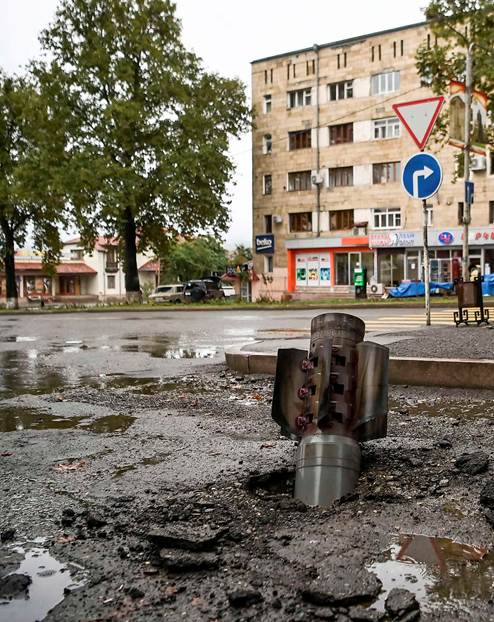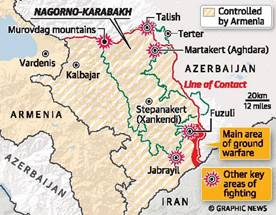Description

Copyright infringement is not intended
Context: The conflict between Armenia and Azerbaijan over Nagorno-Karabakh has been at the centre of three major wars and multiple clashes for decades. The recent flare-up began on August 3 after Azerbaijan claimed that it had captured the territory in Karabakh in a retaliatory campaign, after an Armenian attack killed one Azerbaijani soldier.
What happened?
- The Nagorno-Karabakh conflict remains stalemated despite the several ceasefire agreements reached in the past.
- Both Baku and Yerevan claim absolute historic ownership of the region which is located within the boundaries of Azerbaijan but is populated largely by ethnic Armenians.
- Following Azerbaijan’s announcement of capturing Karabakh, the military in Nagorno-Karabakh disputed the claim and accused Azerbaijan of killing two soldiers, declaring a “partial mobilisation” in response to the clash.
- Armenia has called on the international community to help stop Azerbaijan’s “aggressive actions” claiming that it continues its “policy of terror” against the population of Nagorno-Karabakh.
- Russia has also accused Azerbaijan of breaking the ceasefire agreement of 2020 and claimed that it was “taking measures to stabilise the situation” with Armenian and Azerbaijani representatives.
Background:
Russia brokered a new peace deal between Armenia and Azerbaijan who have been in a military conflict for over six weeks over the disputed region of Nagorno-Karabakh in the South Caucasus. Over 1200 have died and thousands displaced.
What Is The Deal?
- Both sides will now maintain positions in the areas that they currently hold, which will mean a significant gain for Azerbaijan as it has reclaimed over 15-20 per cent of its lost territory during the recent conflict.
- All military operations are suspended, Russian peacekeepers will be deployed along the line of contact in Nagorno-Karabakh and along the Lachin corridor that connects the region to Armenia.
- These Russian peacekeepers with a force of roughly 2,000 will be deployed in the area for a period of five years.
- Refugees and internally displaced persons will return to the region and the adjacent territories and the two sides will also exchange prisoners of wars and bodies.
- A new corridor will be opened from Nakhchivan to Azerbaijan, which will be under Russian control.

Russia’s Role:
- Russia’s role in the conflict has been somewhat opaque since it supplies arms to both countries and is in a military alliance with Armenia called the Collective Security Treaty Organisation.
- Russia “has always taken a balanced position” on the matter and has “traditionally good relations” with both countries.
Issue:
- The genesis of the conflict is in the flawed creation of an Armenian Christian majority autonomous region, Nagorno-Karabakh, on the territory of a Muslim majority Azerbaijan.
- While the area remains in Azerbaijan, it is today governed by separatist Armenians who have declared it a republic called the “Nagorno-Karabakh Autonomous Oblast”. While the Armenian government does not recognise Nagorno-Karabakh as independent, it supports the region politically and militarily.
- In July 1921, when the South Caucasus was being incorporated into the evolving USSR, Nagorno-Karabakh’s repeated petitions to Moscow for its merger with Armenia were turned down.
- When the Soviet Union began to collapse in the late 1980s, Armenia’s regional parliament voted for the region’s transfer to Armenia; the Soviet authorities turned down the demand.
- Years of clashes followed between Azerbaijan forces and Armenian separatists.
- In 1994, Russia brokered a ceasefire, by which time ethnic Armenians had taken control of the region.
- Even after the 1994 peace deal, the region has been marked by regular exchanges of fire.
- In 2016, it saw a Four-Day War before Russia mediated peace. OSCE Minsk Group, chaired by France, Russia and the US, has tried to get the two countries to reach a peace agreement for several years.
- the current clashes were possibly a fallout of Azerbaijan’s bid to reclaim some territories occupied by separatist Armenians.
- Since the conflict started in September, multiple ceasefire agreements have been signed, but none so far have been successful.

Analysis:
- Prima facie, the conflict is between two countries and is territorial in nature. However, several regional/ global players like Russia, USA , Europe, Turkey and Iran are also involved to secure their strategic, security and economic interests in the region.
- India doesn’t have a publicly articulated policy for South Caucasus (unlike Neighbourhood First, Act East /Central Asia Connect).
- There is visible asymmetry in India’s relations with Armenia, Azerbaijan.
- Armenia is the only country in the region with which it has a friendship and cooperation Treaty. India has received three heads of states from Armenia, but none from Azerbaijan. Armenia extends its unequivocal support to India on Kashmir issue whereas Azerbaijan not only supports but also promotes Pakistan’s narrative on this issue.
- The levels of India’s trade or investment with Armenia are, however, very low. In the case of Azerbaijan, GAIL and ONGC/OVL have made relatively small investments. Azerbaijan falls on the International North South Transport Corridor route.
- In the initial stages of the conflict, India endorsed the concept of respect for territorial integrity. But now, India has adopted a balanced and neutral stance and made a politically correct statement in which it has expressed its concern, called for restraint and immediate cessation of hostilities and resolution of the conflict peacefully through diplomatic negotiations.
https://epaper.thehindu.com/Home/ShareArticle?OrgId=GLGA5G3SF.1&imageview=0















